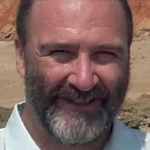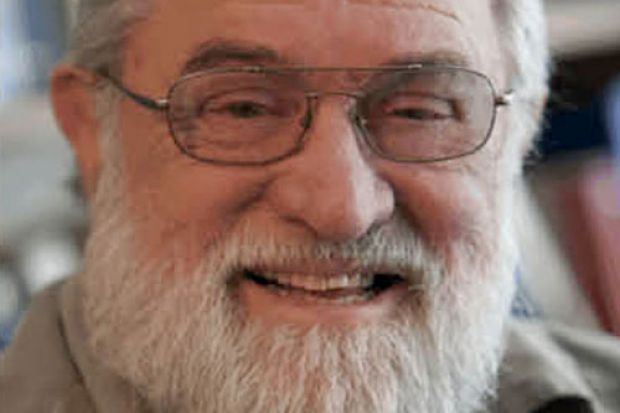Last winter, at the height of the record-breaking storms that Britain endured, the South Coast was particularly affected. Partly because its soft shores are not usually assailed in this manner, the effects were dramatic. Overnight, the sea wall from which I swim every day had been felled as if tipped over by a wilful child. Built from Quarr stone, robbed out of the dissolved medieval monastery at nearby Netley, this solid construction had been unable to withstand the normally calm seas of Southampton Water being roused to fury by the wind and a high spring tide. I was utterly shocked at the sight – the remains resembled a pile of post-Blitz rubble. But if I had read The Last Beach, I would have been even more worried.
In the new genre of science-based apocalyptic non-fiction that serves to open our eyes to the effects of the Anthropocene – the recently designated geological era in which it can be concluded that our species is having an unalterable effect on our planet – Orrin Pilkey and Andrew Cooper’s book is a terrifying addition to a growing and doomy bookshelf. Pilkey, professor emeritus of geology at Duke University, and Cooper, professor of coastal studies at the University of Ulster, have created a wide-ranging survey of the state of our beaches – the essential and incredibly fragile interface between us and the sea.
Remote Hawaiian beaches are composed of 70 per cent plastic nurdles - the raw pellets that go to make up our plastic world
The beach is our last resort – if you’ll forgive the pun. It is where the land runs out, and where we gravitate on our annual, aestival migrations to the water’s edge. We stand there, looking out, like the Manhattan water-gazers of Herman Melville’s Moby-Dick, and see ourselves, and our souls, reflected in the sea. With the encroachment of modern life and its digital demands we seem to be driven ever closer to those margins – some in search of solace or recuperation, others in search of economic relief. Witness the daily boatloads of desperate migrants leaving the developing world for ours. (After the infamous capsizing off Lampedusa in October 2013, when more than 300 Eritreans died, it transpired that the refugees had been told that they would be sailing straight from the North African coast into London itself.)
Such a pitiful longing for other shores is a sharp contrast to the fact that the highest property values in the UK are to be found at Sandbanks on Poole Harbour, where hedge fund managers and footballers spend millions merely to live within sight of that same poetic but freighted medium, the sea.
The watery world laid out by Pilkey and Cooper is not a happy one. It is one where, in the UK alone, litter on beaches has increased by 121 per cent since 1994. Where remote Hawaiian beaches are composed of 70 per cent plastic nurdles – the raw pellets that go to make up our plastic world. Where Californian surfers lose limbs from infections caught from contaminated water.
Even the sand itself is toxic. In a list that this writer – as an open-water year-round swimmer – finds more chilling than the Solent at 4am on a pitch-dark February morning, the authors advise: “1. Don’t walk barefoot on the beach. 2. Don’t lie on the sand. Lie on a thick towel or blanket. 3. Never, ever get buried in beach sand.” The reason? New evidence suggests that there are more faecal particles in the sand than there are in the muckiest sea.
There are welcome glimpses of optimism here, however, as The Last Beach hymns the sea and its margins for their recreational and restorative powers. “We must view the beach as a sacred and resilient yet strangely fragile natural environment to be protected at all costs,” Pilkey and Cooper insist. But time and again (and their writing does suffer from the academic’s love of repetition and the tendency to tell the reader what they are about to say, say it, then tell the reader what they’ve just said) the authors stress that the argument comes down to one dilemma: buildings and beaches; the two don’t mix.
Creating defensive sea walls is almost always done to protect expensive beachfront property, rather than the lives and livelihoods of “ordinary” people. Sea walls, whether composed of concrete, boulders or even old cars, rapidly denude a natural beach of its sand by forestalling the processes by which it is renewed. High-end resorts buy in sand to replenish their beaches for the benefit of high-spending customers. But that sand has to come from someone else’s beach – usually a location without the financial or political wherewithal to defend its resources. Sand mining is done illegally around the world, and Pilkey and Cooper are not loath to name the guilty nations. Suffice to say that neither Singapore nor Dubai comes out of this book very well.
But they also blame the very notion of beach engineering itself. Their especial ire is reserved for the US Army Corps of Engineers, the go-to, government-financed body whose first response to disaster seems to be to lay down some serious concrete, ignoring all those elemental lessons of long-shore drift that we learned about in geography class. In the authors’ opinion, the Corps’ lack of both foresight and hindsight is a direct result of the vested financial interests of powerful beachfront property and business owners.
As ever, money and power talk, even on the beach, even in the face of the increasingly serious storms that the US has suffered in recent years during Hurricanes Sandy and Irene. After the latter hit the US east coast in 2011, for instance, the Corps pumped 200,000 cubic metres of sand on to Atlantic Beach, New Jersey. Within five months it had disappeared, leaving a 9m-high cliff cut into the shoreline, and an estimated bill of $4 million to deal with it. Rising seas around the world will multiply these bills by millions because of such misguided, short-term schemes, with beaches needing to be replaced every few years.
In contrast, the authors speak glowingly of our own National Trust and its realistic attitude to the many hundreds of miles of coastline that it owns. At Brownsea Island in Poole Harbour, the Trust has decided not to renew steel and wooden pilings and gabions set in place in the 1970s, preferring that the beach find its own level.
Such apparent laissez-faire must strike terror into the wealthy homeowners just across the harbour. Meanwhile, on nearby Studland beach – famous for its nudists and its sea horses – the practice of removing sea grass has been discontinued, despite some local opposition to the “smelly” seaweed. As a result of the natural fertilisation, native plants such as sea rocket are helping to stabilise the shore and the dunes behind.
We imagine we can design a beach, shape it like a sandcastle. Because it sits so close to us – often within sight of our cities and towns – we think we can conform it to our own image, as an adjunct to our culture. This invaluable book makes clear what we stand to lose by continuing to make such assumptions. The Last Beach did not make my swim this morning much happier, but it does provide its own alarm call – as well as offering a plan of action to reclaim the beach, for ourselves and for future generations.
The Last Beach
By Orrin H. Pilkey and J. Andrew G. Cooper
Duke University Press, 168pp, £46.00 and £12.99
ISBN 9780822357988 and 58091
Published 21 November 2014
The authors
“I live in Hillsborough, North Carolina – where General Cornwallis spent some time – with my wife Sharlene and dog Buddy, a Jack Russell,” says Orrin Pilkey.
Pilkey, the James B. Duke professor emeritus of geology at Duke University and founder and director emeritus of the Program for the Study of Developed Shorelines at Western Carolina University, was born in New York City “but raised in Washington State on the other side of the continent. I definitely became a geologist because of my upbringing in the desert, where there were lots of minerals and interesting rocks. I learned to love the outdoors.”
He confesses that he “was not studious in high school or as an undergrad. I finally saw the light when I married Sharlene, who was raised in an Alaskan fishing village and with whom I shared a love for the outdoors.” And, he recalls, “I had a high school teacher who actually praised my writing, which shocked and inspired me.”
Of his time at Washington State College where he completed a BSc, “the only adjective that applies was ambivalent,” says Pilkey. “I was having a very good time but was serious only about my geology classes.”
Pilkey’s family lost their home in Hurricane Camille in 1969. Asked if we are now any better at preventing the worst effects of extreme weather events, he says, “Camille began the transformation but it took Katrina and New Orleans to start making real changes and to recognise that our Army Corps of Engineers was politicised to the point of incompetence in some of their coastal projects.”
What advances does he hope for in his area of science? “I would like to see honest, objective and careful studies of various aspects of beach replenishment and the impact of seawalls on beaches. At present these aspects of applied beach science remain guesswork, open to the overoptimism, etc, of individual beach project successes. It makes our science vulnerable to wayfaring rogue consultants.”
Asked what developments give him hope that environmental issues are being taken more seriously, he notes that “things are changing fast. A minor example: when I started fieldwork in the marine environment, we would throw all our garbage over the side, in everything from skiffs to research vessels. Now we don’t.”
Pilkey has no shortage of honours and awards to his credit, but those he is proudest of, he says, are the 1987 Francis P. Shephard medal for excellence in marine geology, awarded by the Society for Sedimentary Geology, “and the naming of a new building after me at the Duke University Marine Lab”. And if a good fairy were to offer him the gift of any skill, he would, he says, ask to be “more patient, diplomatic and brighter!”

Belfast-born Andrew Cooper, professor of coastal studies at the University of Ulster, has lived in Coleraine for 20 years with his wife Amanda. Their children Graham (21) and Claire (19) are at university in Bath and Liverpool, respectively.
Cooper was, he says, “the antithesis of studious as a child. It was only when I embarked on research that I really began to flourish academically.” He credits “the enthusiasm of my first geology teacher, John Neeson, and my parents patiently driving me to endless rock outcrops” in helping his early interest in the field to develop.
After a first degree at Queen’s University Belfast, Cooper moved to South Africa to take his MSc and doctorate at the University of Natal (now part of the University of KwaZulu Natal).
During his nine years in South Africa studying estuaries, beaches and the seabed, he “worked with a group of enthusiastic scientists in some beautiful places and became aware of the amazing research potential of the coast. I found I was quite good at research and grew in confidence and enthusiasm myself.”
“My professor in Durban, Tom Mason, was the biggest influence on my career as a geologist. He gave the right mix of encouragement and direction to allow me to succeed in a research and academic career. Of course, it was only with the willing support of my wife, Amanda, that I was able to pursue my research career on the world’s beaches.”
Cooper has worked with Pilkey “for about 12 years now, and we have travelled much of the world together. He has been an enormous encouragement to me, and since we first collaborated we have found it easy and enjoyable to work together.
“We have much in common – for example, before we met, each of us had amassed, quite independently, a large collection of airsickness bags from various airlines. But we are also able to challenge each other and have a really stimulating debate. We have found that we work together very easily and have had a lot of fun. Orrin’s experience really helped me to develop my research career.”
What would he most like to know about his field of study that is presently unknown? “The whole area of how beaches change as sea level rises is still poorly understood,” he observes. “There is no unifying model and perhaps there never will be, but I would like to make progress in this area.”
Asked what environmental developments give him hope, Cooper says: “I see encouragement in initiatives like that taken by the National Trust with respect to its coastal properties that involves not interfering in the coast and instead allowing nature to take its course. It will result in land loss and loss of property, but will allow the coast to continue to operate and provide benefits to humans as it has always done. It is a brave initiative that I hope other organisations and governments will follow.”
Whitepark Bay on the north Antrim coast is his favourite beach in Northern Ireland, Cooper says. “It is backed by high chalk cliffs and extensive sand dunes. There are spectacular views across it from the surrounding countryside, and it has an unusual set of crescentic bars. Access involves a fairly steep climb so often the beach is deserted and peaceful. Occasionally, outcrops of Jurassic clay are exposed on the beach from which fossils can be collected.”
Invited to make a request of the talent-bestowing good fairy, Cooper says he “would like to be better organised and able to attend to administrative matters more efficiently”.
Karen Shook
Register to continue
Why register?
- Registration is free and only takes a moment
- Once registered, you can read 3 articles a month
- Sign up for our newsletter
Subscribe
Or subscribe for unlimited access to:
- Unlimited access to news, views, insights & reviews
- Digital editions
- Digital access to THE’s university and college rankings analysis
Already registered or a current subscriber? Login





